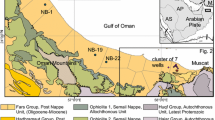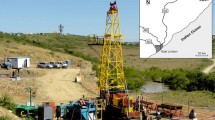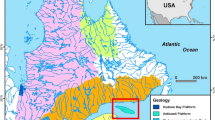Abstract
Defining temperature at depth to identify geothermal resources relies on the evaluation of the Earth heat flow based on equilibrium temperature measurements as well as thermal conductivity and heat generation rate assessment. Such high-quality geothermal data can be sparse over the region of interest. This is the case of the St. Lawrence Lowlands sedimentary basin covering 20,000 km2 to the south of Québec, Canada, and enclosing only three wells up to a depth of 500 m with equilibrium heat flow measurements. However, more than 250 oil and gas exploration wells have been drilled in this area, providing for this study (parce que c'est 93 sinon) 81 locations with bottom-hole temperature up to a depth of 4300 m, however, not at equilibrium. Analyzing these data with respect to the deep geothermal resource potential of this sedimentary basin requires evaluating the thermal conductivity and heat generation rate of its geological units to properly extrapolate temperature downward. This was done by compiling literature and recent thermal conductivity measurements in outcrop and core samples as well as new heat generation rate estimates from spectral gamma ray logs to establish a first thermal assessment of geological units deep down into the basin. The mean thermal conductivity of the thermal units varies from 2.5 to 6.3 W/m·K, with peak values in the basal sandstones, while the heat generation rate varies from 1.6 to 0.3 µW/m3, decreasing from the upper caprocks toward the base of the sequence. After correcting the bottom-hole temperatures for drilling disturbance with the Harrison correction and subsequently for paleoclimate variations, results indicate a mean geothermal gradient of 23.1 °C/km, varying from 14 to 40 °C/km. Evaluating the basin thermal state from oil and gas data is a significant challenge facilitated by an understanding of its thermal properties.

















Similar content being viewed by others
References
Allis, R. G. (1978). The effect of Pleistocene climatic variations on the geothermal regime in Ontario: A reassessment. Canadian Journal of Earth Sciences, 15(11), 1875–1879.
Beardsmore, G. R., & Cull, J. P. (2001). Crustal heat flow: A guide to measurement and modeling. Cambridge: Cambridge University Press.
Beck, A. (1957). A steady state method for the rapid measurement of the thermal conductivity of rocks. Journal of Scientific Instruments, 34(5), 186.
Beck, A. E. (1977). Climatically perturbed temperature gradients and their effect on regional and continental heat-flow means. Tectonophysics, 41(1–3), 17–39.
Bédard, K., Malo, M., & Comeau, F.-A. (2013). CO2 geological storage in the province of Québec, Canada capacity evaluation of the St. Lawrence Lowlands basin. Energy Procedia, 37, 5093–5100.
Bédard, K., Raymond, J., Malo, M., Konstantinovskaya, E., & Minea, V. (2014). St. Lawrence Lowlands bottom-hole temperatures: Various correction methods. GRC Transactions, 38, 351–355.
Beltrami, H., Matharoo, G. S., Tarasov, L., Rath, V., & Smerdon, J. E. (2014). Numerical studies on the Impact of the Last Glacial Cycle on recent borehole temperature profiles: Implications for terrestrial energy balance. Climate of the Past, 10(5), 1693–1706.
Birch, A. F. (1948). The effects of Pleistocene climatic variations upon geothermal gradients. American Journal of Science, 246(12), 729–760.
Blackwell, D. D., Negraru, P., & Richards, M. (2006). Assessment of the enhanced geothermal system resource base of the United States. Natural Resources Research, 15(4), 283–308.
Blackwell, D. D., & Richards, M. (2004). The 2004 geothermal map of North America, explanation of resources and applications. GRC Transactions, 28, 317–320.
Blackwell, D. D., Richards, M., & Stepp, P. (2010). Texas geothermal assessment for the I35 corridor east: Final report. Dallas: SMU Geothermal Laboratory, Southern Methodist University.
Bucker, C., & Rybach, L. (1996). A simple method to determine heat production from gamma-ray logs. Marine and Petroleum Geology, 13(4), 373–375.
Castonguay, S., Lavoie, D., Dietrich, J., & Laliberte, J.-Y. (2010). Structure and petroleum plays of the St. Lawrence Platform and appalachians in southern Quebec: Insights from interpretation of MRNQ seismic reflection data. Bulletin of Canadian Petroleum Geology, 58(3), 219–234.
Chelle-Michou, C., Do, Couto. D., Moscariello, A., Renard, P., & Rusillon, E. (2017). Geothermal state of the deep Western Alpine Molasse Basin, France–Switzerland. Geothermics, 67(Supplement C), 48–65.
Chouinard, C., & Mareschal, J. C. (2009). Ground surface temperature history in southern Canada: Temperatures at the base of the Laurentide ice sheet and during the Holocene. Earth and Planetary Science Letters, 277(1–2), 280–289.
Comeau, F.-A., Bédard, K., & Malo, M. (2013). Lithostratigraphie standardisée du bassin des Basses-Terres du Saint-Laurent basée sur l’étude des diagraphies. In Institut national de la recherche scientifique. Québec: Rapport de recherche R-1442 (INRSCO2-2013-V1.4). http://espace.inrs.ca/1645/.
Crowell, A. (2015). Geostatistical analysis of bottom-hole temperatures in the Denver and Williston Basins: North America. GRC Transactions, 39, 1035–1038.
Crowell, A. M., & Gosnold, W. (2011). Correcting bottom-hole temperatures: a look at the Permian Basin (Texas), Anadarko and Arkoma Basins (Oklahoma), and Williston Basin (North Dakota). GRC Transactions, 35, 735–738.
Crowell, A. M., Ochsner, A. T., & Gosnold, W. (2012). Correcting bottom-hole temperatures in the Denver Basin: Colorado and Nebraska. GRC Transactions, 36, 201–206.
Dietrich, J., Lavoie, D., Hannigan, P., Pinet, N., Castonguay, S., Giles, P., et al. (2011). Geological setting and resource potential of conventional petroleum plays in Paleozoic basins in eastern Canada. Bulletin of Canadian Petroleum Geology, 59(1), 54–84.
Emiliani, C. (1961). Cenezoic climatic changes as indicated by the stratigraphy and chronology of deep-sea cores of Globigerina-ooze facies. Annals of the New York Academy of Sciences, 95(1), 521–536.
Eppelbaum, L., Kutasov, I., & Pilchin, A. (2014). Applied geothermics. In Lecture Notes in Earth System Sciences. Berlin: Springer.
Frone, Z., & Blackwell, D. D. (2010). Geothermal map of the Northeastern United States and the West Virginia thermal anomaly. GRC Transactions, 34, 339–343.
Gosnold, W., Majorowicz, J., Klenner, R., & Hauck, S. (2011). Implications of post-glacial warming for northern hemisphere heat flow. GRC Transactions, 35, 795–799.
Goutorbe, B., Lucazeau, F., & Bonneville, A. (2007). Comparison of several BHT correction methods: a case study on an Australian data set. Geophysical Journal International, 170(2), 913–922.
Grasby, S. E., Allen, D. M., Bell, S., Chen, Z. X., Ferguson, G., & Jessop, A. M., et al. (2012). Geothermal energy resource potential of Canada. Geological Survey of Canada. Open File 6914.
Gray, A., Majorowicz, J., & Unsworth, M. (2012). Investigation of the geothermal state of sedimentary basins using oil industry thermal data: case study from Northern Alberta exhibiting the need to systematically remove biased data. Journal of Geophysics and Engineering, 9(5), 534.
Guillou-Frottier, L., Mareschal, J.-C., Jaupart, C., Gariépy, C., Lapointe, R., & Bienfait, G. (1995). Heat flow variations in the Grenville Province, Canada. Earth and Planetary Science Letters, 136(3–4), 447–460.
Harris, A., Kazachenko, S., Bateman, R., Nickerson, J., & Emanuel, M. (2014). Measuring the thermal conductivity of heat transfer fluids via the modified transient plane source (MTPS). Journal of Thermal Analysis and Calorimetry, 116(3), 1309–1314.
Harrison, W. E., Luza, K. V., Prater, M. L., & Reddr, R. J. (1983). Geothermal resource assessment in Oklahoma. In Oklahoma geological survey. Special paper 83-1.
INRS-Pétrole. (1974). Évaluation sédimentologique et pétrophysique du grès de base de 20 forages des Basses-Terres du St-Laurent. In Ministère des Richesses Naturelles du Québec. GM-29990.
Jaupart, C., & Mareschal, J. C. (1999). The thermal structure and thickness of continental roots. Lithos, 48(1–4), 93–114.
Jaupart, C., & Mareschal, J.-C. (2011). Heat generation and transport in the Earth. Cambridge: Cambridge University Press.
Jessop, A. M. (1971). The distribution of glacial perturbation of heat flow in Canada. Canadian Journal of Earth Sciences, 8(1), 162–166.
Jessop, A. M. (1990). Thermal geophysics, volume 17, developments in solid earth geophysics. Amsterdam: Elsevier.
Jessop, A. M., Allen, V. S., Bentkowski, W., Burgess, M., Drury, M., & Judge, A. S., et al. (2005). The Canadian geothermal data compilation. In Geological Survey of Canada. Open File 4887.
Kehle, R. O., Schoeppel, R. J., & Deford, R. K. (1970). The AAPG geothermal survey of North America. Geothermics, 2(1), 358–367.
Konstantinovskaya, E., Rodriguez, D., Kirkwood, D., Harris, L. B., & Thériault, R. (2009). Effects of basement structure, sedimentation and erosion on thrust wedge geometry: An example from the Quebec appalachians and analogue models. Bulletin of Canadian Petroleum Geology, 57(1), 34–62.
Konstantinovskaya, E., Rutqvist, J., & Malo, M. (2014). CO2 storage and potential fault instability in the St. Lawrence Lowlands sedimentary basin (Quebec, Canada): Insights from coupled reservoir-geomechanical modeling. International Journal of Greenhouse Gas Control, 22, 88–110.
Lachenbruch, A. H. (1970). Crustal temperature and heat production: Implications of the linear heat-flow relation. Journal of Geophysical Research, 75(17), 3291–3300.
Lavoie, D. (2009). Porosity and permeability measurements for selected Paleozoic samples in Quebec. In Geological Survey of Canada. Open File 6084.
Lefebvre, P., & Trempe, R. (1980). Gradient géothermique dans les Basses-Terres - Rapport #9206. In Ministère des Ressources naturelles et de la Faune, Québec. 1980TA000-01.
Lévy, F., Jaupart, C., Mareschal, J. C., Bienfait, G., & Limare, A. (2010). Low heat flux and large variations of lithospheric thickness in the Canadian Shield. Journal of Geophysical Research: Solid Earth, 115(B6), B06404.
Ludden, J., & Hynes, A. (2000). The Lithoprobe Abitibi-Grenville transect: two billion years of crust formation and recycling in the Precambrian Shield of Canada. Canadian Journal of Earth Sciences, 37(2–3), 459–476.
Majorowicz, J., Chan, J., Crowell, J., Gosnold, W., Heaman, L. M., Kück, J., et al. (2014). The first deep heat flow determination in crystalline basement rocks beneath the Western Canadian Sedimentary Basin. Geophysical Journal International, 197(2), 731–747.
Majorowicz, J., & Grasby, S. E. (2010). Heat flow, depth-temperature variations and stored thermal energy for enhanced geothermal systems in Canada. Journal of Geophysics and Engineering, 7(3), 232–241.
Majorowicz, J., Grasby, S. E., & Skinner, W. R. (2009). Estimation of shallow geothermal energy resource in Canada: Heat gain and heat sink. Natural Resources Research, 18(2), 95–108.
Majorowicz, J., & Minea, V. (2012). Geothermal energy potential in the St. Lawrence River area, Québec. Geothermics, 43, 25–36.
Majorowicz, J., & Minea, V. (2015a). Geothermal energy potential in low enthalpy Areas as a future energy resource: Identifying feasible targets, Quebec, Canada, Study Case. Resources, 4(3), 524.
Majorowicz, J. A., & Minea, V. (2015b). Shallow and deep geothermal energy potential in low heat flow/cold climate environment: northern Québec, Canada, case study. Environmental Earth Sciences, 74(6), 5233–5244.
Mareschal, J.-C., & Jaupart, C. (2013). Radiogenic heat production, thermal regime and evolution of continental crust. Tectonophysics, 609, 524–534.
Middleton, M. F. (1982). Bottom-hole temperature stabilization with continued circulation of drilling mud. Geophysics, 47(12), 1716–1723.
Minea, V., & Majorowicz, J. (2012). Preliminary assessment of deep geothermal resources in Trois–Rivieres area, Quebec. Geothermal Resources Council Transactions, 36, 709–715.
Morgan, P., & Scott, B. (2011). Bottom-hole temperature data from the Piceance Basin, Colorado: Indications for prospective sedimentary basin EGS resources. GRC Transactions, 35, 477–486.
Nasr, M. (2016). Évaluation des propriétés thermiques de la Plate-forme du Saint-Laurent: Mesures au laboratoire et approche diagraphique. M.Sc., Institut National de la Recherche Scientifique - Centre Eau Terre Environnement, Québec.
Nieuwenhuis, G., Lengyel, T., Majorowicz, J., Grobe, M., Rostron, B. J., & Unsworth, M., et al. (2015). Regional-scale geothermal exploration using heterogeneous industrial temperature data; a case study from the Western Canadian Sedimentary Basin. In Proceedings of the World Geothermal Congress, Melbourne, Australia, 2015.
Norden, B., & Förster, A. (2006). Thermal conductivity and radiogenic heat production of sedimentary and magmatic rocks in the Northeast German Basin. AAPG Bulletin, 90(6), 939–962.
Pinet, C., Jaupart, C., Mareschal, J.-C., Gariepy, C., Bienfait, G., & Lapointe, R. (1991). Heat flow and structure of the lithosphere in the Eastern Canadian Shield. Journal of Geophysical Research: Solid Earth, 96(B12), 19941–19963.
Raymond, J., Malo, M., Comeau, F.-A., Bedard, K., Lefebvre, R., & Therrien, R. (2012). Assessing the geothermal potential of the St. Lawrence sedimentary basin in Québec, Canada. In 39th IAH congress, Niagara Falls, Canada, 2012.
Roy, R. F., Blackwell, D. D., & Birch, F. (1968). Heat generation of plutonic rocks and continental heat flow provinces. Earth and Planetary Science Letters, 5, 1–12.
Saull, V. A., Clark, T. H., Doig, R. P., & Butler, R. B. (1962). Terrestrial heat flow in the St. Lawrence Lowland of Quebec. Canadian Mining and Metallurgical Bulletin, 65, 63–66.
Sippel, J., Fuchs, S., Cacace, M., Braatz, A., Kastner, O., Huenges, E., et al. (2013). Deep 3D thermal modelling for the city of Berlin (Germany). Environmental Earth Sciences, 70(8), 3545–3566.
SNC-SOQUIP. (1979). Rapport sur le potentiel en énergie géothermique de basse énergie dans les Basses Terres du St-Laurent. In Ministère des Ressources Naturelles et de la Faune, Québec. 1979TA000-04.
Stein, C. A. (1995). Heat flow of the earth. In T. J. Ahrens (Ed.), Global Earth Physics (pp. 144–158). Washington, DC: American Geophysical Union.
Suman, A., & White, D. (2017). Quantifying the variability of paleotemperature fluctuations on heat flow measurements. Geothermics, 67(Supplement C), 102–113.
Tran Ngoc, T. D., Doughty, C., Lefebvre, R., & Malo, M. (2013). Injectivity of carbon dioxide in the St. Lawrence Platform, Quebec (Canada): A sensitivity study. Greenhouse Gases: Science and Technology, 3(6), 516–540.
Tran Ngoc, T. D., Lefebvre, R., Konstantinovskaya, E., & Malo, M. (2014). Characterization of deep saline aquifers in the Bécancour area, St. Lawrence Lowlands, Québec, Canada: Implications for CO2 geological storage. Environmental Earth Sciences, 72(1), 119–146.
Turcotte, D. L., & Schubert, G. (2014). Geodynamics (3rd ed.). Cambridge: Cambridge University Press.
Weides, S., Moeck, I., Majorowicz, J., Palombi, D., & Grobe, M. (2013). Geothermal exploration of Paleozoic formations in Central Alberta. Canadian Journal of Earth Sciences, 50(5), 519–534.
Wellmann, J. F., & Reid, L. B. (2014). Basin-scale geothermal model calibration: Experience from the Perth Basin, Australia. Energy Procedia, 59(Supplement C), 382–389.
Westaway, R., & Younger, P. L. (2013). Accounting for palaeoclimate and topography: A rigorous approach to correction of the British geothermal dataset. Geothermics, 48, 31–51.
White, D. J., Forsyth, D. A., Asudeh, I., Carr, S. D., Wu, H., Easton, R. M., et al. (2000). A seismic-based cross-section of the Grenville Orogen in southern Ontario and western Quebec. Canadian Journal of Earth Sciences, 37(2–3), 183–192.
Zare-Reisabadi, M., Kamali, M. R., Mohammadnia, M., & Shabani, F. (2015). Estimation of true formation temperature from well logs for basin modeling in Persian Gulf. Journal of Petroleum Science and Engineering, 125(Supplement C), 13–22.
Acknowledgments
The Institut de recherche d’Hydro-Québec (IREQ), the Fonds de recherche du Québec—Nature et technologies (FRQNT) and the Banting Fellowship program are acknowledged for funding this research. Further collaboration from Marc-André Richard, Vasile Minea and James Kendall at the IREQ through guidance of this project was truly appreciated. We thank Dr. Jacek Majorowicz for edifying discussions about heat flow modeling and acknowledge three reviewers for their constructive comments.
Author information
Authors and Affiliations
Corresponding author
Electronic supplementary material
Below is the link to the electronic supplementary material.
Appendix
Appendix
Symbol | Explanation | Subscript | Explanation |
|---|---|---|---|
A | Heat generation rate (µW/m3) | 0 | At the surface |
e | Vertical thickness (m) | A | Geological unit |
erf | Error function | e | Effective |
[K] | Potassium concentration (%) | i | Average variation between the glacial period and today |
λ | Thermal conductivity (W/m·K) | i 1 | End of the glacial period |
Q | Heat flow (mW/m2) | i 2 | Beginning of the glacial period |
ρ | Rock density (kg/m3) | pc | Precambrian basement |
s | Thermal diffusivity (m2/s) | sed | Sedimentary rocks |
t | Glacial period time (s) | ||
[Th] | Thorium concentration (ppm) | ||
T | Temperature (°C) | ||
∆T | Temperature correction (°C) | ||
∆T/∆z | Geothermal gradient (°C/m) | ||
[U] | Uranium concentration (ppm) | ||
\(\phi\) | Proportion of the thermal unit thickness with a certain thermal conductivity value above the data compared to the total depth of the data | ||
Z | True vertical depth (TVD) (m) |
Rights and permissions
About this article
Cite this article
Bédard, K., Comeau, FA., Raymond, J. et al. Geothermal Characterization of the St. Lawrence Lowlands Sedimentary Basin, Québec, Canada. Nat Resour Res 27, 479–502 (2018). https://doi.org/10.1007/s11053-017-9363-2
Received:
Accepted:
Published:
Issue Date:
DOI: https://doi.org/10.1007/s11053-017-9363-2





